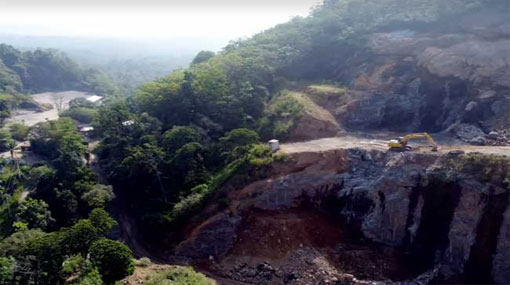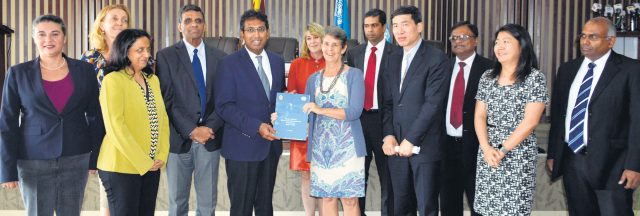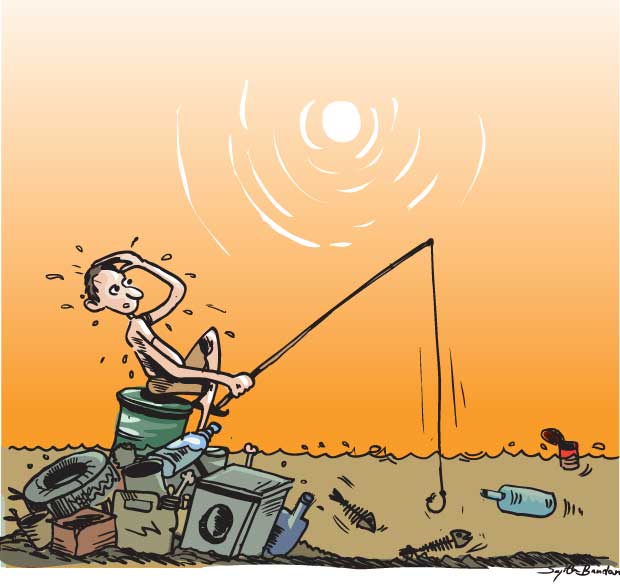
Meepe: another Uma Oya disaster?

The Seethawaka Environmental Protection Association states that the villagers of Padukka, Meepe are being subjected to much distress owing to the rock quarries that are in operation on the Kithul Kanda rock.
A representative of the Association, Indika Wickramasinghe states that an entire side of the rock has by now been either blasted off or removed.
This large-scale mining activity and its consequent environmental damage have reportedly been going on for the past 4 years.
The quarries are said to be primarily supplying rocks and minerals for the Port City project.
The residents of the surroundings are now suffering from a shortage of drinking water, owing to the drying up of catchment areas; a consequence of the Kithul Kanda exploitation.
Indika Wickramasinghe explained that the pH level of the water had also been affected due to contamination with various chemicals.
Furthermore, the operation of the quarries has contributed to severe noise pollution, he added.
Wickramasinghe proceeded to state that that the dust particles added to the atmosphere had resulted in a high incidence of respiratory tract diseases among the populace.
16 rock quarries are currently said to be in operation across a region of about 3.5 square kilometres.
With the involvement of environmental organizations, protests had been launched in March 2017, demanding the termination of the unlawfully functioning quarries.
Although the quarries’ functions had temporarily been halted following the protests, 15 of the quarries had been regranted with permits, once again subjecting the citizens to hardship and distress.
Wickramasinghe pointed out that heavy rains, coupled with the intense mining, had resulted in landslides as well, putting the lives of human beings at risk.
He stated that no comprehensive assessment had been made prior to the issuing of permits by the Geological Survey and Mines Bureau.
Accordingly, he urged the authorities to take action and prevent the continuation of the aforementioned quarries which cause significant damage to both the environment and the villagers.
Chief Incumbent of the Sri Poorwarama Maha Viharaya of Uthumpe, Ven. Mahagama Hemathilaka Thero, in response to an inquiry made by Ada Derana, also reiterated Indika Wickramasinghe’s request from the authority to provide an immediate solution to the villagers suffering from the numerous problems caused by the exploiting of the Kithul Kanda rock in Meepe.
Source – AdaDerana, See more at – http://www.adaderana.lk/news/42617/meepe-another-uma-oya-disaster

Sustainable Development Framework signed
The Government and the United Nations signed the 2018 – 2022 UN Sustainable Development Framework (UNSDF), the agreement which pegs UN assistance to Sri Lanka’s long term development priorities, on Thursday (3).
The UNSDF provides the overarching framework for the work of the United Nations in Sri Lanka in line with the national priorities of the Maithri Palanayak, Sthaavara Ratak: A Compassionate Governance, A Stable Country, the Public Investment Programme, the 2030 Agenda for Sustainable Development and the Sustainable Development Goals. The UNSDF was signed by M. I. M. Rafeek, Secretary, Ministry of National Policies and Economic Affairs and Ms. Una McCauley, UN Resident Coordinator and UNDP Resident Representative in the presence of Deputy Minister of National Policies and Economic Affairs, Dr. Harsha De Silva, and UN ASG, UNDP Regional Director and chair of the Regional UN Development Group, Haoliang Xu, along with representatives of the UN Country Team.
Speaking on the Framework Xu stated “The UNSDF will support the Government to achieve peaceful, just, inclusive and sustainable development with a special focus on leaving no one behind and reaching the furthest behind first.”
Elaborating on the UNSDF, Dr. De Silva, said “We are extremely pleased that the UN will be investing over USD 300 million for the development of Sri Lanka over the next 5 years. The 4 strategic areas of the framework; improved data, innovative public institutions, social security and resilience to climate change and disaster and especially evidence based policy planning are extremely important for the development of Sri Lanka.”.
The UN Country Team in Sri Lanka worked in collaboration with the Government, and in consultation with civil society and development partners, to ensure that the framework is grounded in the realities of the country. The UNSDF serves as a common strategy in four strategic areas of focus; towards improved data, knowledge management and evidence based policy; strengthened, innovative public institutions and engagement towards a lasting peace; social security and socio economic resilience; and enhancing resilience to climate change and disasters and strengthening environmental management.
The UNSDF will guide the collaborative work of UN agencies for 2018 – 2022 and support national efforts to reduce disparities and make a positive difference in the lives of all people.
Source – Nation, See more at =- http://nation.lk/online/2017/08/05/sustainable-development-framework-signed.html

Listen to the Ocean

Though divided on many issues, the National Unity Government is to stay together at least till 2020, largely for the survival of the two major parties though there will also be benefits for the common good of the people.
Thankfully the UNP and the SLFP have no disputes on one major issue — the restrictions on the use of plastics, silli silli bags and polythene lunch sheets, though some polythene producers protested this week. Over the weekend, media reports said that from more than 50,000 multi-day trawlers fisher-folk are known to be dumping into the ocean tens of thousands of plastic water bottles. They probably are not aware of the calamity they are causing.
The Fisheries Ministry needs to educate them on global warming issues and also help find alternative means for them to carry drinking water. On this issue the Government also needs to educate schoolchildren and other sections of society. These programmes could be conducted in schools and at peak time on State television, cutting down on tele-dramas which are popular and profitable though they have little more than entertainment or gossip value.
The devastating magnitude of the global warming catastrophe was again spotlighted last week.
Scientists first discovered a soup-like rubbish patch of plastic floating between Hawaii and California in the 1980s. But decades on it appears that the Great Pacific Garbage Patch might not be the only one. According to reports, scientists have found yet another collection of marine debris and they say it is about the same size as Mexico.
Nestled between Chile and Easter Island in the South Pacific, the new patch is a collection of small plastic fragments that are tricky to spot with the naked eye. It comes as seafood lovers were warned that they ate 11,000 pieces of toxic plastic every year.
The South Pacific patch was uncovered by a team of researchers and volunteers led by Captain Charles Moore during a six-month voyage aboard the ORV Alguita ship. “We discovered tremendous quantities of plastic,” Capt Moore told Research Gate. “My initial impression is that our samples compare to what we were seeing in the North Pacific in 2007, so it’s about ten years behind,” Capt. Moore said.
Capt. Moore, who has spent years raising awareness of plastic pollution since he saw the North Pacific patch while captaining a racing yacht in the 1990s, believes the patch could be more than 380,000 square miles. Patches like this form around rotating ocean currents which are called gyres. The term “patch” referring to the plastic pollution in oceanic gyres can be misleading. The pieces of plastic are not necessarily floating bottles, bags, and buoys, but tiny pieces of plastic resembling confetti, making them almost impossible to clean up. These microplastic particles may not be visible floating on the surface, but in this case, they were detected after collecting water samples on Capt. Moore’s recent six-month expedition to the remote area that had only been explored for plastic once before.
Henderson Island, located in this South Pacific region, was recently crowned the most plastic-polluted island on Earth, as researchers discovered it was covered in roughly 38 million pieces of trash.
The problem of plastic pollution is becoming ubiquitous in the oceans, with 90 per cent of sea birds consuming it and more than eight million tons of new plastic trash finding its way into the oceans every year.
With such a calamity facing us, the Sri Lanka Government needs to take top measures to prevent pollution of the ocean around us. If we destroy the oceans, we will be destroying ourselves. Recently the Government took major steps to convert garbage or solid waste into electricity. Some contractors are using 5-litre plastic bottles filled with silli silli bags as part of their building foundation along with cement and sand. Similar creative, innovative and imaginative measures need to be reflected on, not only experts but also by families, to stop or reverse the dangerous trend towards global warming.
http://www.dailymirror.lk/article/Listen-to-the-Ocean-135285.html




